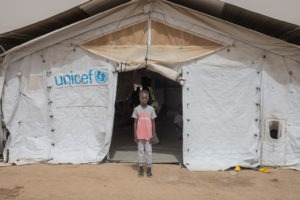August 14, 2024 – One in five children – or 466 million – live in areas that experience at least double the number of extremely hot days every year compared to just six decades ago, according to a new UNICEF analysis.
Using a comparison between a 1960s and a 2020-2024 average, the analysis issues a stark warning about the speed and scale at which extremely hot days – measured as more than 35 degrees Celsius/95 degrees Fahrenheit – are increasing for almost half a billion children worldwide, many without the infrastructure or services to endure it.
“The hottest summer days now seem normal,” said UNICEF Executive Director Catherine Russell.
“Extreme heat is increasing, disrupting children’s health, well-being and daily routines.”
The analysis also examines country-level data and finds that in 16 countries, children now experience more than a month of additional extremely hot days compared to six decades ago.
In South Sudan, for example, children are living through a yearly average of 165 extremely hot days this decade compared to 110 days in the 1960s, while in Paraguay it has jumped to 71 days from 36.
Worldwide problem
Globally, children in West and Central Africa face the highest exposure to extremely hot days and the most significant increases over time, according to the analysis. 123 million children – or 39 per cent of children in the region – now experience an average of more than one third of the year – or at least 95 days – in temperatures above 35 degrees Celsius, reaching as many as 212 days in Mali, 202 days in Niger, 198 days in Senegal, and 195 days in Sudan.
In Latin America and the Caribbean, almost 48 million children live in areas that are experiencing twice the number of extremely hot days.
Heat stress within the body, caused by exposure to extreme heat, poses unique threats to the health and well-being of children and pregnant women, particularly if cooling interventions are not available.

It has been linked to pregnancy complications such as gestational chronic diseases and adverse birth outcomes including stillbirth, low birth weight, and preterm birth.
Excess levels of heat stress also contribute to child malnutrition, non-communicable diseases such as heat-related illnesses, and leave children more vulnerable to infectious diseases that spread in high temperatures such as malaria and dengue. Evidence shows that it also impacts neurodevelopment, mental health, and well-being.
Longer heatwaves
Extreme heat also has more concerning effects when experienced in longer periods of time. While extreme heat is increasing in every country worldwide, the analysis shows that children are also exposed to more severe, longer, and frequent heatwaves.
Across 100 countries, more than half of children are experiencing twice as many heatwaves today as 60 years ago. In the United States, for example, 36 million children are exposed to double the number of heatwaves compared to 60 years ago, and 5.7 million are exposed to four times as many.
The impact of climate-related hazards on child health is multiplied by how climate-related hazards affect food and water security and contamination, damage infrastructure, disrupt services for children, including education, and drive displacement.
In addition, the severity of these impacts is determined by underlying vulnerabilities and inequities children face based on their socioeconomic status, gender, location, existing health status and country context.
In the coming months, all Member State Parties to the Paris Agreement must submit new national climate plans – Nationally Defined Contributions (NDC 3.0). These plans will set the course of climate action for a decade.
They are a timebound opportunity to set out concrete plans to realise the goals of the Paris agreement.
UNICEF is calling on leaders, governments and the private sector to seize this opportunity to deliver urgent and bold climate action which upholds the right of every child to a clean, healthy and sustainable environment by taking the following actions:
- REDUCE emissions and fulfil ambitious international sustainability and climate change agreements with urgency to get rising temperatures under control.
- PROTECT the lives, health and well-being of children and the resilience of their communities, including by adapting essential social services to a changing climate, more frequent disasters, and degrading environment. For example, by making sure every health worker is trained to detect and treat heat stress, and by making health and education facilities resilient to extreme heat.
- EMPOWER every child through their life course with the developmental opportunities, education, and skills to be a champion for the environment.
“Children are not little adults. Their bodies are far more vulnerable to extreme heat. Young bodies heat up faster, and cool down more slowly. Extreme heat is especially risky for babies due to their faster heart rate, so rising temperatures are even more alarming for children,” Russell said.
“Governments must act to get rising temperatures under control, and there is a unique opportunity to do that right now.
“As governments are currently drafting their national climate action plans, they can do so with the ambition and knowledge that today’s children and future generations will have to live in the world they leave behind.”
###
Temperature Data is calculated using daily aggregate temperature data from the ERA5 reanalysis (Muñoz, 2019; accessed July 10, 2024), obtained and processed using the Google Earth Engine platform.
Child Population Data taken from Global Human Settlement Population data (GHS-POP – R2023A; Schiavina, 2023; accessed July 10, 2024) were downloaded from the Copernicus ftp site (https://human-settlement.emergency.copernicus.eu/download.php?ds=pop). These data were then adjusted to estimate the child population percentage using the Population Percentage by Select Age Groups – Both Sexes from the World Population Prospects data (United Nations, 2024; accessed July 10, 2024).
UNICEF adopted the following definitions to define heat metrics:
Heatwaves – any period of 3-days or more when the maximum temperature each day is in the top 10% of the local 15-day average.
Heatwave frequency refers to the number of heatwaves per year.
Heatwave duration refers to the total number of days an event lasts.
Heatwave severity refers to the temperature above the local 15-day average during the heat wave, expressed in degrees Celsius.
Extremely high temperatures (extremely hot days) – when a day exceeds 35 °C.
Learn more in UNICEF’s recent report A Threat to Progress.
Learn more about Protecting children from heat stress.




